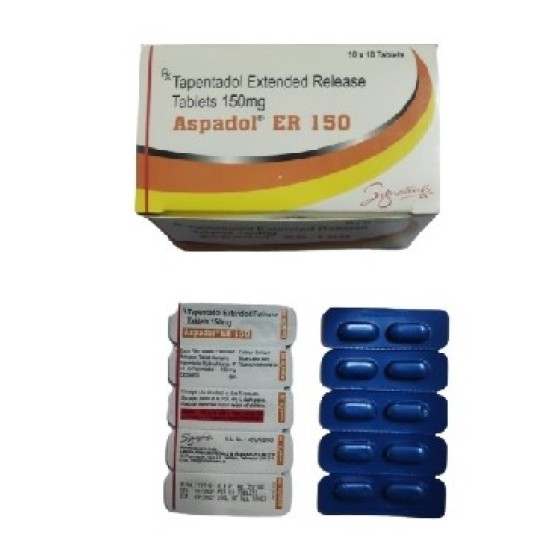Living with chronic or acute pain can be debilitating. Whether caused by injury, surgery, or ongoing health conditions, pain significantly affects the quality of life. For those seeking powerful and reliable relief, Aspadol 150 offers an effective solution. This medication, with tapentadol as its active ingredient, belongs to a class of centrally acting opioid analgesics. It works by altering how the brain and nervous system respond to pain.
What is Aspadol 150mg?
Aspadol tablet is a potent prescription medication used to treat moderate to severe pain. The active ingredient, tapentadol, combines opioid receptor agonism with norepinephrine reuptake inhibition. This dual mechanism provides a powerful analgesic effect, often superior to traditional opioids that work through a single pathway.
Tapentadol first received approval from the U.S. Food and Drug Administration (FDA) in 2008. Since then, it has become a preferred option for pain management, especially when other treatments prove inadequate.
How Aspadol 150mg Works
Tapentadol in Aspadol 150 binds to μ-opioid receptors in the brain and spinal cord. This binding interrupts the transmission of pain signals, producing a numbing or dulling effect. Simultaneously, it inhibits norepinephrine reuptake, which boosts pain inhibition pathways in the central nervous system.
This two-pronged mechanism not only relieves pain but also improves mood and mental outlook, often disrupted by long-term pain. Unlike some opioids, tapentadol offers pain relief with a lower incidence of gastrointestinal side effects like nausea and constipation.
Medical Uses of Aspadol 150mg
Doctors prescribe Aspadol tablet to manage various types of pain, such as:
- Post-surgical pain
- Pain from injuries and fractures
- Chronic musculoskeletal pain
- Neuropathic pain, including diabetic neuropathy
- Cancer-related pain
- Severe arthritis or back pain
Aspadol is suitable for both short-term acute pain and long-term chronic conditions. However, doctors often reserve the 150mg strength for patients already accustomed to opioids or those who need high-dose pain relief.
Dosage and Administration
Patients should take Aspadol 150 orally with water. It can be taken with or without food, though food may help reduce nausea. The dosage frequency depends on the patient’s medical condition, pain intensity, and response to treatment.
Key Dosage Guidelines:
- Take exactly as prescribed. Do not increase or decrease the dose without medical advice.
- Avoid crushing, chewing, or breaking the tablet to prevent rapid release and absorption.
- Maintain a consistent schedule to keep pain levels stable.
Doctors typically start with lower doses and gradually increase to minimize side effects and evaluate tolerance.
Benefits of Aspadol 150mg
- Fast-Acting Relief: Patients often experience pain relief within 30 to 60 minutes of ingestion.
- Dual Action Mechanism: Combines opioid agonism and norepinephrine inhibition for enhanced effectiveness.
- Better Tolerance: Compared to morphine, tapentadol shows fewer gastrointestinal issues.
- Effective in Neuropathic Pain: Unlike many opioids, Aspadol also works well in nerve pain conditions.
- Improves Quality of Life: Helps patients return to daily activities with reduced pain and improved mood.
Side Effects of Aspadol 150mg
Like all medications, Aspadol tablet can cause side effects. Most are mild and resolve as the body adjusts to the medication. However, some may be serious and require immediate medical attention.
Common Side Effects:
- Dizziness or light-headedness
- Nausea or vomiting
- Constipation
- Headache
- Drowsiness
- Dry mouth
Serious Side Effects:
- Slow or shallow breathing
- Severe drowsiness or confusion
- Seizures
- Hallucinations
- Signs of serotonin syndrome (e.g., agitation, fast heartbeat, muscle twitching)
Allergic Reactions:
Though rare, some patients may experience skin rash, swelling, or difficulty breathing. Seek emergency help if any of these occur.
Warnings and Precautions
Before starting Aspadol 150mg, patients should inform their healthcare provider about all current medications, health conditions, and history of substance use. Here are critical precautions to keep in mind:
- Addiction Risk: Aspadol is an opioid and carries a risk of misuse, abuse, and addiction.
- Respiratory Depression: High doses can slow breathing, especially in opioid-naïve users.
- Alcohol Interaction: Avoid alcohol as it increases the risk of sedation and respiratory depression.
- Driving and Operating Machinery: The drug may impair mental or physical abilities; avoid activities requiring alertness.
- Pregnancy and Breastfeeding: Use only if clearly needed. It may cause withdrawal symptoms in newborns.
Who Should Not Use Aspadol 150mg
Do not use Aspadol 150mg if you:
- Have severe asthma or breathing problems
- Suffer from gastrointestinal obstruction or paralytic ileus
- Are allergic to tapentadol or any component of the formulation
- Are using MAO inhibitors (or within 14 days of stopping one)
Patients with liver or kidney impairments should consult their doctor for dose adjustments or alternative options.
Tapentadol vs. Other Painkillers
Compared to traditional opioids like oxycodone or morphine, tapentadol offers several advantages:
- Lower potential for nausea and vomiting
- Reduced constipation rates
- Less sedative effect in some users
- Effective in both nociceptive and neuropathic pain
While not without risks, Aspadol provides a better side-effect profile for many patients, especially those who do not tolerate other opioids well.
Can You Buy Aspadol 150mg Online?
Yes, you can legally purchase Aspadol 150mg online with a valid prescription. Many licensed pharmacies offer home delivery services. Always ensure the online pharmacy is legitimate and approved by regulatory agencies in your country.
Buying Guide:
- Choose a certified online pharmacy.
- Upload or send your doctor’s prescription.
- Verify shipping and return policies.
- Check for customer reviews and legitimacy.
- Avoid websites selling without prescriptions.
Warning: Beware of counterfeit medications from unregulated sources. They may contain incorrect dosages, harmful substances, or no active ingredient at all.
Frequently Asked Questions (FAQs)
1. Is Aspadol 150mg the strongest dosage available?
Yes, 150mg is one of the highest doses available for tapentadol. Lower doses such as 50mg and 100mg are more commonly prescribed, especially for first-time users.
2. Can I take Aspadol every day?
Yes, if prescribed by your doctor. However, daily use increases the risk of dependence. Long-term use should involve regular medical supervision.
3. Can I use Aspadol for migraine or menstrual pain?
Aspadol is not typically prescribed for minor or episodic pain like headaches or menstrual cramps. It is meant for moderate to severe pain.
4. What should I do if I miss a dose?
Take the missed dose as soon as you remember, unless it’s close to the next dose. Do not double the dose to catch up.
5. Is tapentadol addictive?
Yes. Tapentadol is a controlled substance with potential for abuse, especially with prolonged or improper use.
Tapering Off Aspadol
Stopping Aspadol suddenly may cause withdrawal symptoms such as anxiety, sweating, insomnia, and muscle pain. To avoid this, doctors gradually reduce the dose over time. Never stop using Aspadol without medical advice.
Storage and Disposal
- Store in a cool, dry place away from children and pets.
- Do not store in bathrooms due to moisture.
- Dispose of unused tablets through a drug take-back program. Do not flush them unless instructed.
Conclusion: Is Aspadol 150mg Right for You?
Aspadol 150mg offers robust and reliable relief for people battling moderate to severe pain. Its dual-action mechanism, better gastrointestinal tolerance, and broad applicability make it a preferred choice among pain management specialists. However, it is a powerful opioid and must be used responsibly under medical supervision.
If you are considering Aspadol for your pain management plan, consult your healthcare provider to determine if it suits your needs. Used correctly, it can significantly improve your comfort, mobility, and overall quality of life.



